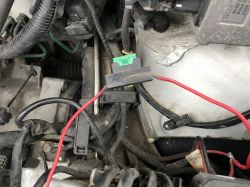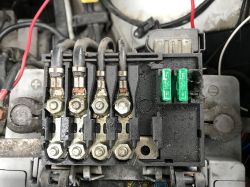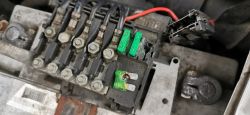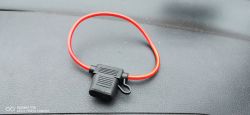FAQ
TL;DR: On SEAT Ibiza II FL, the AC/radiator fan circuit uses a 30 A fuse; "there is nothing to play with in the measurements." Fix melting by replacing burned sockets, using a proper 30 A holder and wiring, and verifying contact quality. [Elektroda, jdubowski, post #17127113]
Why it matters: This helps Ibiza II FL owners stop fuse/holder overheating that can damage wiring and compromise Climatronic cooling.
Quick Facts
- The AC/radiator fan circuit is protected by a 30 A fuse; size your holder and wiring accordingly. [Elektroda, jdubowski, post #17127113]
- Lukewarm under load is acceptable; “When it is lukewarm, there is no problem.” [Elektroda, jdubowski, post #17127756]
- If the fuse is correct and not blowing, the fans are unlikely the culprit. [Elektroda, jdubowski, post #17127060]
- Overheating isolated at the fuse contacts indicates high contact resistance at the socket. [Elektroda, kindlar, post #17127051]
- For diagnosis, measure current with a clamp ammeter on the fan feed. [Elektroda, dare23, post #17127066]
How do I fix a melting AC/radiator fan fuse socket on my SEAT Ibiza II FL?
The root cause is usually poor fuse contact that burns the socket. Replace the damaged fuse box or add a proper external holder. Use wiring and a holder adapted to the 30 A circuit; avoid thin 1 mm² leads. This restores low-resistance contact and stops localized heating. [Elektroda, jdubowski, post #17127113]
Is a warm fan fuse normal when the AC is on?
Yes. A fuse that is only lukewarm under load is acceptable. As one expert noted, “When it is lukewarm, there is no problem.” If temperatures climb beyond that, inspect contacts and the holder. [Elektroda, jdubowski, post #17127756]
Should I replace the entire fuse box or add an external fuse holder?
On older cars, adding a correctly rated external fuse in a quality holder is often preferable. Full fuse-box replacement must be done professionally, or new problems may be introduced in higher-current sections. [Elektroda, jdubowski, post #17127129]
What wire size and fuse holder should I use for the fan circuit?
Use a quality holder rated for 30 A and appropriately thick wiring. Avoid 1 mm² wiring and cheap 10 A car-radio-style holders, as they overheat on this load. Adapt both wires and socket to 30 A duty. [Elektroda, jdubowski, post #17127113]
Do I need to measure the fan current? How do I do it safely?
If diagnosing, measure current in the fan feed with a clamp ammeter. This avoids breaking the circuit and reduces risk. Do the measurement after you address obvious bad contacts or burned holders. Replace the fuse box once the root cause is solved. [Elektroda, dare23, post #17127066]
If the fuse doesn’t blow, could the fans still be the problem?
Unlikely. If the fuse is in the correct position and does not blow, the fans are “not to blame.” Focus on the fuse socket, holder quality, and wiring. [Elektroda, jdubowski, post #17127060]
Why did my old fuse box melt and look greasy?
That residue can be pyrolysis products from a burned fuse socket. It results from high-resistance contact heating the plastic until it degrades and chars. Replace the damaged socket or box. [Elektroda, jdubowski, post #17127207]
How hot is “too hot” for the fuse during AC use?
One owner reported that after about 15 minutes, the fuse burned fingers on touch and the housing softened. Treat that as a fault condition and investigate contact integrity. [Elektroda, driver400, post #17127081]
Where is the fan control module, and should I check it?
If heat persists after fixing the fuse holder and contacts, inspect the fan control module under the crossmember beneath the battery. It was flagged by an owner as a next check. [Elektroda, driver400, post #17129481]
Is cleaning dirty fuse contacts worth it?
Yes, contamination can cause poor contact at the fuse terminals. If you see greasy dirt, clean and re-check tightness. If the socket shows burn marks, replace it instead of reusing. [Elektroda, dare23, post #17127187]
Do I have to replace the fuse box after a melt?
Yes. After you detect and eliminate the cause, replacement of the fuse box is obligatory. Melted or charred sockets won’t maintain safe, low-resistance contact. [Elektroda, dare23, post #17127066]
Can a cheap bypass or dangling wires cause a fire risk?
Yes. Poor-quality holders, thin wires, and dangling connections are dangerous. As one expert warned, “the fire brigade usually arrives to put out the rest of the vehicle.” Use proper materials and secure routing. [Elektroda, jdubowski, post #17127060]
The cable is hot only within 1 cm of the fuse—what does that indicate?
Localized heating at the contact area points to high contact resistance at the socket. The rest of the cable staying cool suggests the load is not the issue; the connection is. [Elektroda, kindlar, post #17127051]
After replacing the case, the fuse is only lukewarm—what does that mean?
That’s a good sign. Lukewarm indicates acceptable operating temperature under load. Continue monitoring after longer drives and ensure the new holder and contacts remain tight. [Elektroda, jdubowski, post #17127756]
Quick 3‑step: How do I stop the fuse melting for good?
- Replace the burned socket or add a proper external holder rated 30 A.
- Rewire with adequately thick conductors; avoid 1 mm² and flimsy 10 A holders.
- Don’t try to read 30 A on a universal meter; use equipment suited to this load.
[Elektroda, jdubowski, post #17127113]








